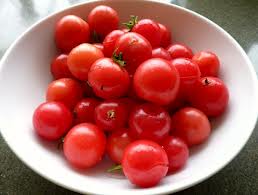We have had a not bad crop of cherry tomatoes this year, although the cherry plum tomatoes are yet to ripen. Anyway, I posted a snapshot of the first pick and my friend Eladio Ramos posted his wonderful family gazpacho recipe for me to share. I don’t think I have quite 2 kg so may have to scale down the recipe. The really neat thing about Eladio’s recipe is that you can swap out the tomatoes for strawberries (of which we’ve also had a decent crop) and turn a savoury starter into dessert.

Regular gazpacho
2 kg of red ripe tomatoes
1 middle size cucumber
1 green pepper (capsicum)
100 gr of white bread (better if it has two or three days, and it has turned stiff, but doesn’t have any mould!)
Two spoons of olive oil
One spoon of a good vinegar
Salt
Put the bread into water to get it soaked.
In the meantime, wash and cut the tomatoes and pepper.
Peel and cut the cucumber and add.
Add salt, oil, vinegar and the soaked bread.
Crush it all well with an electric blender. Then use a strainer to make it softer. You can add some cold water (I never put in more than 100 ml).
Let it go cold in the fridge.
Serve as a starter or for a country supper with a Mediterranean feel.
2. Strawberry gazpacho:
The same recipe but change 1/2kg of tomatoes with 1/2 kg of strawberries and don’t add the green pepper prepared as follows:
Wash and cut in 3-4 pieces the strawberries. Put them in a dish and add 2 spoons of white sugar and 2 spoons of vinegar. Mix well and put into the fridge (better if you let it macerate for 12-24 hours).
Serve for dessert.
Now for the science bit: fresh vegetables and fruit (actually tomatoes are fruit strawberries aren’t!), highly coloured (red) important as those pigment compounds have potential antioxidant and other physiological properties. In particular, lycopene the red in tomatoes is purportedly useful in reducing a man’s risk of prostate cancer. Strawberries contain no lycopene, so stick with the soup and have a sorbet for dessert.
You may not know that tomatoes belong to the nightshade family of plants (Solanaceae), which also includes tomatoes, peppers, aubergine (eggplant), cape gooseberry, potatoes, mandrake, and deadly nightshade.